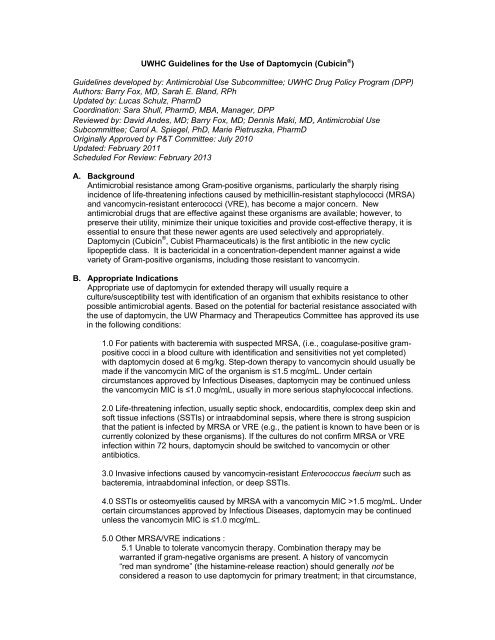Antimicrobial Use Guidelines (AMUG) version 21 - UW Health
Antimicrobial Use Guidelines (AMUG) version 21 - UW Health
Antimicrobial Use Guidelines (AMUG) version 21 - UW Health
Create successful ePaper yourself
Turn your PDF publications into a flip-book with our unique Google optimized e-Paper software.
<strong>UW</strong>HC <strong>Guidelines</strong> for the <strong>Use</strong> of Daptomycin (Cubicin ® )<strong>Guidelines</strong> developed by: <strong>Antimicrobial</strong> <strong>Use</strong> Subcommittee; <strong>UW</strong>HC Drug Policy Program (DPP)Authors: Barry Fox, MD, Sarah E. Bland, RPhUpdated by: Lucas Schulz, PharmDCoordination: Sara Shull, PharmD, MBA, Manager, DPPReviewed by: David Andes, MD; Barry Fox, MD; Dennis Maki, MD, <strong>Antimicrobial</strong> <strong>Use</strong>Subcommittee; Carol A. Spiegel, PhD, Marie Pietruszka, PharmDOriginally Approved by P&T Committee: July 2010Updated: February 2011Scheduled For Review: February 2013A. Background<strong>Antimicrobial</strong> resistance among Gram-positive organisms, particularly the sharply risingincidence of life-threatening infections caused by methicillin-resistant staphylococci (MRSA)and vancomycin-resistant enterococci (VRE), has become a major concern. Newantimicrobial drugs that are effective against these organisms are available; however, topreserve their utility, minimize their unique toxicities and provide cost-effective therapy, it isessential to ensure that these newer agents are used selectively and appropriately.Daptomycin (Cubicin ® , Cubist Pharmaceuticals) is the first antibiotic in the new cycliclipopeptide class. It is bactericidal in a concentration-dependent manner against a widevariety of Gram-positive organisms, including those resistant to vancomycin.B. Appropriate IndicationsAppropriate use of daptomycin for extended therapy will usually require aculture/susceptibility test with identification of an organism that exhibits resistance to otherpossible antimicrobial agents. Based on the potential for bacterial resistance associated withthe use of daptomycin, the <strong>UW</strong> Pharmacy and Therapeutics Committee has approved its usein the following conditions:1.0 For patients with bacteremia with suspected MRSA, (i.e., coagulase-positive grampositivecocci in a blood culture with identification and sensitivities not yet completed)with daptomycin dosed at 6 mg/kg. Step-down therapy to vancomycin should usually bemade if the vancomycin MIC of the organism is ≤1.5 mcg/mL. Under certaincircumstances approved by Infectious Diseases, daptomycin may be continued unlessthe vancomycin MIC is ≤1.0 mcg/mL, usually in more serious staphylococcal infections.2.0 Life-threatening infection, usually septic shock, endocarditis, complex deep skin andsoft tissue infections (SSTIs) or intraabdominal sepsis, where there is strong suspicionthat the patient is infected by MRSA or VRE (e.g., the patient is known to have been or iscurrently colonized by these organisms). If the cultures do not confirm MRSA or VREinfection within 72 hours, daptomycin should be switched to vancomycin or otherantibiotics.3.0 Invasive infections caused by vancomycin-resistant Enterococcus faecium such asbacteremia, intraabdominal infection, or deep SSTIs.4.0 SSTIs or osteomyelitis caused by MRSA with a vancomycin MIC >1.5 mcg/mL. Undercertain circumstances approved by Infectious Diseases, daptomycin may be continuedunless the vancomycin MIC is ≤1.0 mcg/mL.5.0 Other MRSA/VRE indications :5.1 Unable to tolerate vancomycin therapy. Combination therapy may bewarranted if gram-negative organisms are present. A history of vancomycin“red man syndrome” (the histamine-release reaction) should generally not beconsidered a reason to use daptomycin for primary treatment; in that circumstance,
















